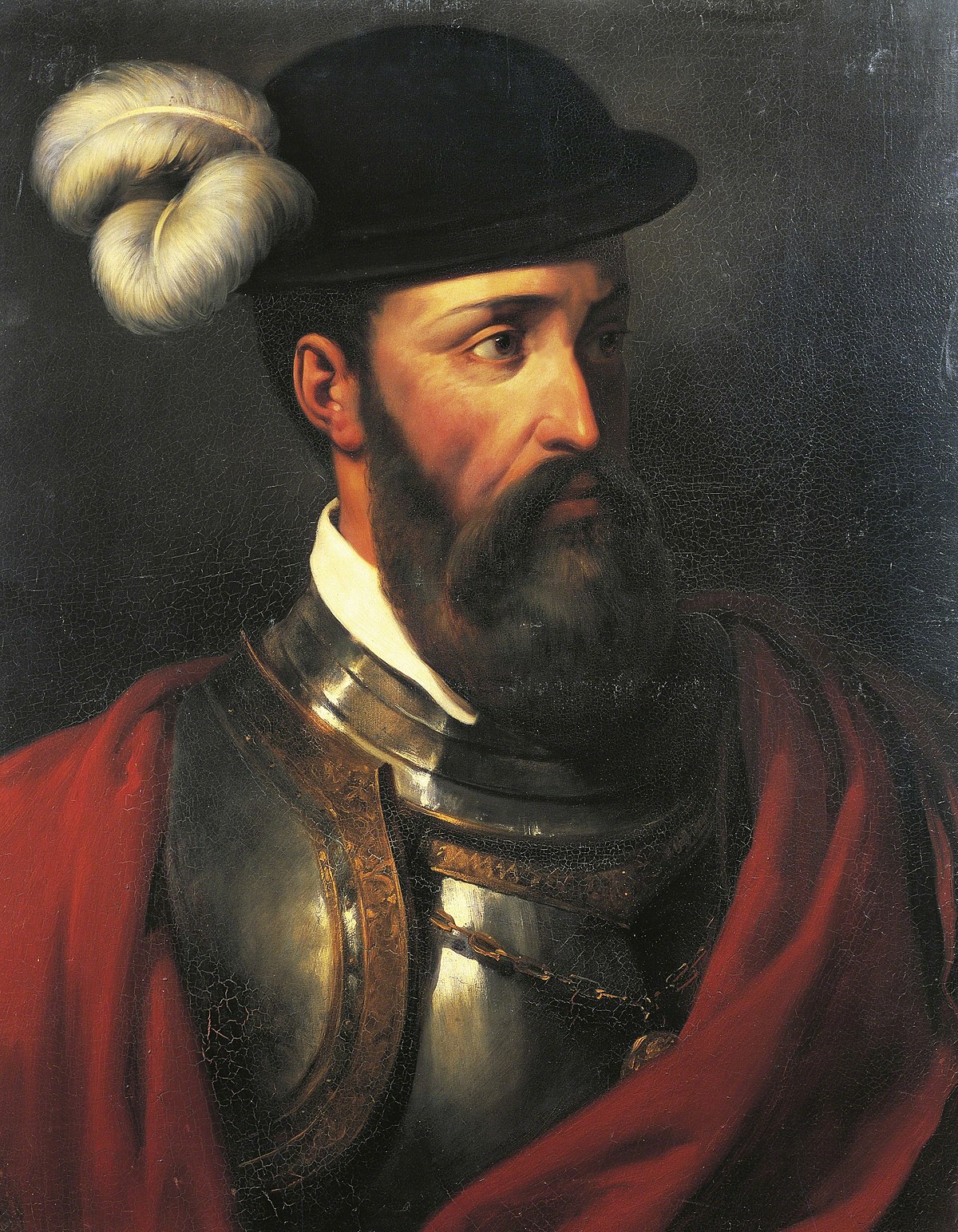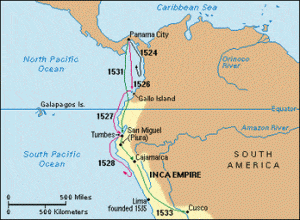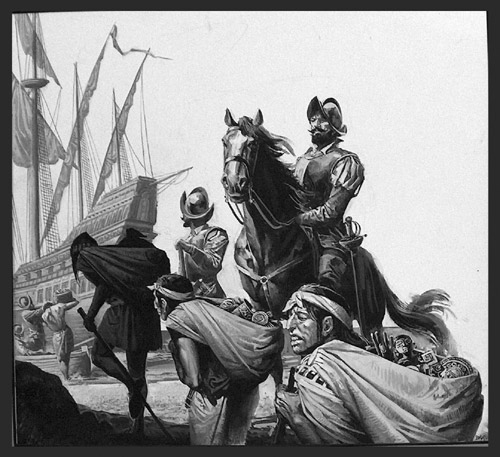Francisco Pizarro (1471 - 26 June 1541) was born in Spain as an illegitimate son of the wealthy colonel Gonzalo Pizarro and a poor, beautiful woman named Francisca Gonzalez.

Francisco would carry his mother's first name and his father's last name. After struggling in the feudal society of the medieval world, he gained recognition for his leadership ability as well as navigation skills.
He joined Vasco de Nunez Balboa in his expedition to the Pacific Ocean but turned on him and aided with Balboa's arrest and execution.
Jump to:
Pizarro was infatuated with the riches that Hernan Cortes had gained with the conquering of the Aztec civilization and sought to acquire wealth and a name for himself in the new world. The Spanish conquistador set his sights on another wealthy empire of the new world, The Incas of South America.
After initially being rejected the opportunity, he pled his case to King Charles I of Spain (King Charles V of the Holy Roman Empire), who gave him a license and great authority over the conquered territories. Francisco Pizarro was successful in his conquest of the Incas.
Early Life of Francisco Pizarro
As stated earlier, Francisco Pizarro was the bastard son of a well-known infantry colonel in Spain. His mother was a beautiful woman but of poor standing in the community.
He probably grew up illiterate and had to learn much of his skills through trial and error. He showed tremendous leadership skills at a young age as well as a healthy ambition.
During his early 20s, Christopher Columbus and Vasco da Gama opened up new trades that would make Spain and Portugal world powers. He participated in the expedition to the Pacific with Vasco de Nunez Balboa and gained notoriety when he arrested Balboa, who was then executed.
Discovering and Conquering the Incan Empire
Hernan Cortes conquered the Aztec people and acquired a vast amount of wealth and power. Pizarro, being a distant cousin of Cortes, sought this same power.
He set his sites in the Incan Empire in Peru, South America. He had learned of the Incas through a rumor from the South American native peoples. they told him of a vast empire full of precious metals.
In response to this, Pizarro led three expeditions to verify these claims. Once verified, he would then get permission to conquer the natives.
First expedition
Pizarro's first expedition was funded and supported by the Governor of Panama, Pedro Arias Davila. However, the first expedition was a complete failure and would result in losing some of its trust in Davila.
Pizarro began his expedition in September of 1524. He attempted to sail the coast of Columbia but was met with harsh weather and hostile natives. This resulted in disrupting his supply line, which caused starvation and unnecessary casualties to the hostile natives. Pizarro ended the first expedition and returned to Panama.
Second expedition
Two years later, Pizarro prepared for another expedition. He acquired permission from a reluctant Governor, Davila, and began his expedition in August of 1526. He sailed into the Columbian San Juan River, where he began to explore the new territory. The terrain in Columbia was not easy to navigate. It was often swampland full of mosquitoes and disease.
Pizarro's second in command, Almagro, was sent back to Panama for reinforcements, and Bartolome Ruiz continued to explore the coast of South America and sailed near the equator. Here, he captured some natives who possessed various objects, including precious metals that Pizarro was seeking.
After capturing these natives, he sailed back to meet up with Pizarro, who had seen no success in his portion of the expedition. Upon learning of the discoveries that were made, the morale of Pizarro's men rose.
They then set sail for the land that had been expedited by Ruiz. Unfortunately, their travel was difficult due to harsh weather, but they managed to reach the Ecuadorian coast.
They encountered natives that had been recently conquered by the powerful Incas, but they did not engage much with them as they were outnumbered and ill-equipped. This ended the second expedition of Pizarro.
King Charles I
The failure of Pizarro's two expeditions to bring anything substantial back to the Spanish mainland caused the new Governor, Pedro de los Rios, to command that the expeditions cease and that Pizarro and his men return.
It was here that Francisco Pizarro displayed his great leadership abilities when he convinced thirteen men to stay behind him and continue the expedition. The thirteen continued to explore the lands and continued to learn of a powerful leader who ruled over these lands. Pizarro saw an opportunity to gain much wealth due to superior Spanish technology and an ability to ally himself with other natives using the same tactic that Cortes had used: divide and conquer. Pizarro then returned to speak to the new governor to convince him to conquer these wealthy natives.
Pedro de los Rios could not be convinced, so Francisco Pizarro decided to appeal to King Charles I of Spain.
He met with King Charles in Toledo and convinced him that the third expedition was worth it. King Charles gave Pizarro permission and a license to conquer the natives. Pizarro took his time in planning the third expedition and properly staffed and manned his ships and crew.
His brothers Juan and Gonzal and his cousin Pedro joined him on the expedition. He then sailed from Spain to La Gomera, where met his other brother, Hernando, and the remaining forces needed to begin the expedition. He then left for Panama and began his final expedition on December 27, 1530.
Conquest of the Incan Empire

Pizarro landed near the coasts of Ecuador, where he found a small portion of gold, silver, and emeralds.
He sent these to Almagro, who was still in Panama gathering more recruits for the expedition. Pizarro engaged the Punian natives at the Battle of Puna.
Superior Spanish technology and tactics devastated the natives. After the battle, the Spanish had only 3 dead, while the Punians had 400 dead or wounded. The battle almost destroyed an entire native people group.
After the battle, Hernando de Soto (who would gain his own fame as a conquistador later) aided Pizarro and explored Tumbes. Upon arriving, he found the location deserted and utterly destroyed by the Puritans.
Pizarro then continued his expedition and established the first Spanish settlement in Peru and named it Can Miguel de Piura. He then sent out Hernando de Soto to explore new lands and sent back information. De Soto was an excellent explorer, gifted leader, and capable diplomat.
When he arrived back, he came with an envoy from the Inca with an invitation for a meeting with the Spaniards.
Pizarro's next contact with the Incan civilization was with the monarch, Atahualpa. Pizarro marched for almost two months towards Cajamarca and initiated meetings with Atahualpa. Atahualpa refused to pay tribute to the Spaniards, believing that his superiority in numbers (80,000 warriors to 200 Spaniards) was enough to defeat the Spanish. This resulted in the Battle of Cajamarca.

The Spanish soundly defeated the Incas, and Pizarro then executed Atahualpa. This execution was not a popular move by Pizarro. He angered not only his brother Hernando and the valuable conquistador de Soto but also King Charles I.
In 1534, Pizarro invaded Cuzco, finished the conquest of Peru, and established the capital city of Lima. A final effort was made by the Incan people to reclaim Cuzco, but they were successfully repelled by Almagro. After this, a dispute between Pizarro and Almagro arose a battle was fought between the two.
Almagro was defeated at the Battle of Las Salinas and executed by Pizarro's brothers. Almagro's son, Diego, was stripped of his lands and left bankrupt by Pizarro. A sad end to a successful friendship that led to the conquest of the Incan Empire.
Assassination and Legacy

The dispute between the Almagro family and the Pizarro family came to a breaking point in 1541 when Diego Almagro II raided Pizarro's palace and assassinated him. At the time, Pizarro was around 70 years old but still managed to kill 3 men before being able to draw his sword.
While dying, Pizarro painted a cross in his own blood from his dying body and cried for Jesus Christ. It is reported that he wailed, "Come to my faithful sword, companion of all my deeds," shortly before his death. Diego Almagro II was caught and executed soon after.
Pizarro's conquest, compared to Cortes, is usually considered a greater accomplishment due to the limited resources and men that he had.
Cortes was able to utilize the divide-and-conquer tactic and gain healthy alliances with other natives who despised the Aztecs.
The Inca people had secured most of the natives and ruled over them for a considerable amount of time. Pizarro was forced to fight battle after battle against much greater numbers and odds than Cortes.
